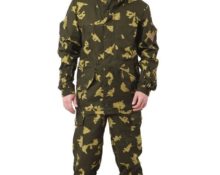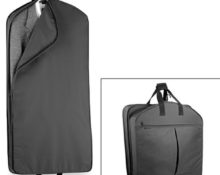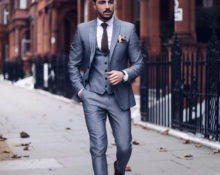Chuvash are a people of the Turkic linguistic group living in the Volga region: in the Chuvash Republic, Tatarstan, Bashkortostan, in the Samara and Ulyanovsk regions. This small nation by Russian standards carefully preserves its traditions. Chuvash folk costume is a national treasure! Some examples of outfits have been preserved from the 18th century! Grandmother's and grandfather's outfits are worn on major national holidays and are a source of pride for the owners.
Traditional costume - traditional materials
According to centuries-old traditions, the Chuvash made their own clothes. Hemp and flax linen and sheep's wool were woven by women in every family. Girls were taught to spin, weave and embroider from childhood. Homemade cloth, leather, and felt were used to sew outerwear.
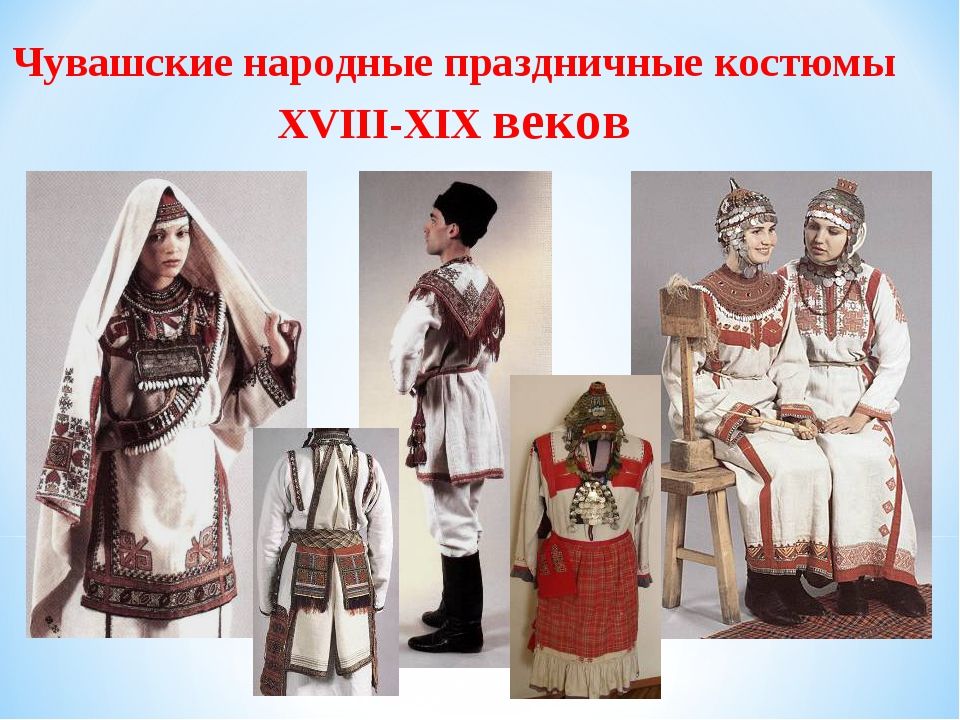
The main color in the clothes was white - the natural color of the canvas. To give greater whiteness, the fabrics were laid out on the snow in early spring under the bright rays of the sun.
Colored threads for embroidery were obtained by dyeing yarn with decoctions of oak bark, roots and leaves of madder and other plants.
Kepe shirts made of hemp fabric were worn by both men and women. They differed in length, cut at the collar and protective embroidery.
Features of women's outfits
Summer clothes
On women's shirts, the neckline was cut out in the middle, and the ornament featured amulets in the shape of the Sun. It was believed that special patterns protected from evil spirits. The embroidery and braid that covered the seams were most often red. It symbolized life. Women wore aprons or aprons over their shirts, also richly embroidered. It’s not for nothing that Chuvashia is called the land of a hundred thousand patterns! They put pants on their legs, since the length of the shirt was approximately mid-calf. The set was complemented by a sara belt and a bright decoration on the hips with embroidery in silk and wool, with fringe. The ornament symbolized the structure of the Universe.
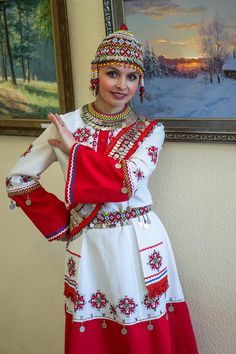
Warm clothes
The outer “demi-season” clothing for women was caftan-robes or cloth caftans. Winter clothing - waist-length sheepskin coats.
IMPORTANT. The more ruffles there were on a fur coat, the richer its owner: the more skins were used in sewing!
Girls clothes
Their family status could also be recognized by the girls’ clothes: orphans had one oblique stripe embroidered on the top of their shirts instead of two. Another decoration was simple patterns along the hem. From the age of 12-14, girls prepared the dowry themselves.
Hats
Tukhya - a hat of unmarried girls - is similar in shape to a Russian military helmet. Embroidery, beads and coins attached in a special order covered the entire surface of the cap. Tukhya was worn until marriage, and then passed on to the younger sister.
Married women on weekdays wore a surpan - a veil in the form of a strip of white fabric with embroidery.On holidays - hushpa: a hat completely covered with bead embroidery and silver coins. From the back of the head to the waist (sometimes below) a khuri was attached to the hushpu - a wide strip also with rows of coins and bead embroidery. The longer the khuri, the richer its owner.
Features of men's suits
Summer clothes
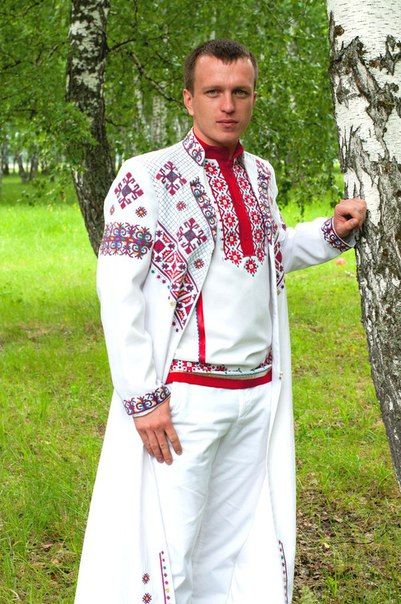 Men's cap shirts had a collar cut on the right. Everyday shirts were undecorated; festive and ritual shirts were embroidered along the neck, shoulders, bottom of the sleeves and hem. The pattern contained symbols of sky and fire. Men also wore trousers (yem) and a sleeveless vest without decorations.
Men's cap shirts had a collar cut on the right. Everyday shirts were undecorated; festive and ritual shirts were embroidered along the neck, shoulders, bottom of the sleeves and hem. The pattern contained symbols of sky and fire. Men also wore trousers (yem) and a sleeveless vest without decorations.
Warm clothes
Men's “demi-season” clothes were canvas, cloth caftans or robes. In winter, instead of linen ones, they wore cloth pants and kerek sheepskin coats.
IMPORTANT. Rich Chuvash people added a sheepskin coat made of black sheepskin to their fur coats.
Clothes for boys
Boys were dressed like adults, only without ritual embroidery. A plain pattern on the collar of the shirt is the only decoration.
Hats
Men wore yalkas summer hats made of thin felt and seleka winter hats with a high band and elongated top. They were not decorated.
Shoes
Summer shoes everywhere were bast bast shoes of a special weave, with onuchas or cloth stockings in winter. Until the 19th century, felt boots and felt boots were a sign of wealth. In the 19th century, leather boots also appeared on women.
Wedding dresses of the bride and groom
The wedding dresses were especially beautiful.
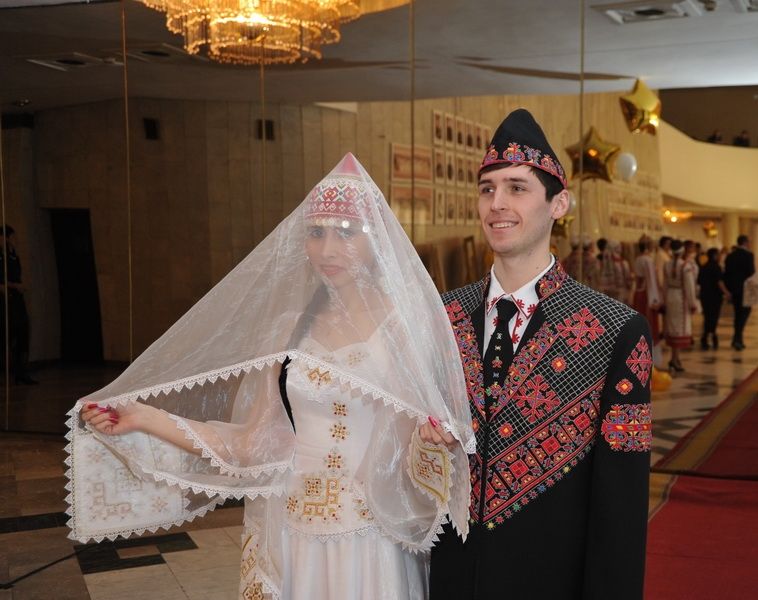
A woman's wedding attire with a headdress, necklaces, breast jewelry, bracelets, pendants, and rings weighed about a pound (16 kg)! The bride was covered with a white perkenchek blanket with ritual embroidery. During the wedding ceremony, the bride's girl's headdress was changed to a woman's one.
The groom dressed in an embroidered shirt, a caftan with a blue or green belt, boots and a fur hat with a coin in front.
IMPORTANT. A special item was a scarf that the groom wore on his shoulders from the moment of successful matchmaking until the wedding. The girl embroidered the scarf in advance and gave it to the groom. This meant that she agreed to get married.
Features of national costumes of different ethnic groups
Among the Chuvash, there are two ethnic groups based on their residence relative to the Volga: the upper (viryal) and the lower (anatri). Between them are the middle-lower Chuvash (Anat-Enchi), their dialect is closer to the Viryaly, and the details of their costume are closer to the Anatri.
Anatri
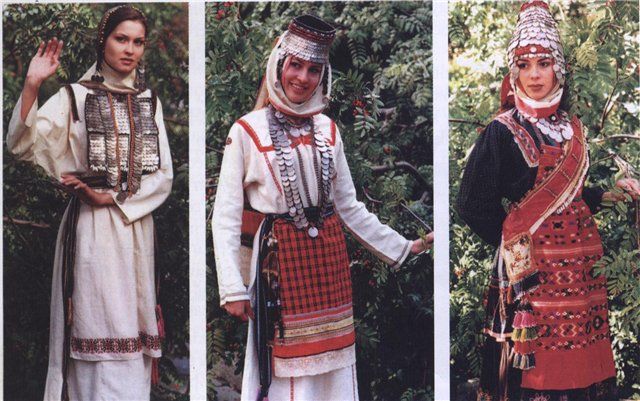
The Anatri borrowed a lot from the Tatar peoples. In the embroidery, the main color is red, and the large geometric pattern turns into a floral one. In the 19th century, Anatri borrowed aniline dyes for fabric from merchants. Everyday clothes became multi-colored, called motley. Striped and checkered woven patterns are common. Festive and ritual attire remained white. The tukhya cap is pointed, like a military helmet, with earmuffs, beadwork and a large number of silver coins. The surpan of a married woman, anathri, is very large - up to 2.5 m. It was decorated with braid, ribbons, lace, and of course, embroidery. It was secured with a pus tutri bandage.
Anat-enchi
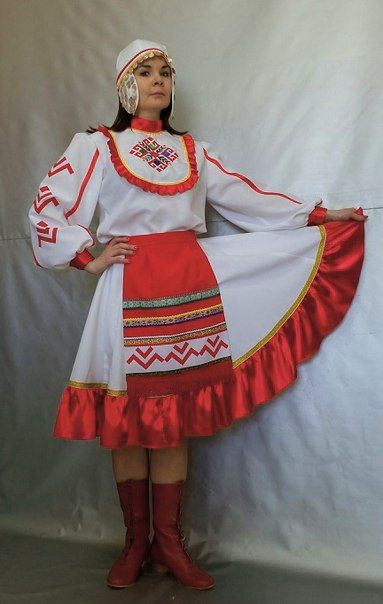
Anat-enchi's patterns are dominated by bright colors of light green, yellow, and red, and there are both geometric and floral patterns. Motley also became their favorite clothing. Tukhya anat-enchi is very similar to the anatri cap, but without the sharp tip on the top. Surpan - narrower and shorter than that of anatri, was decorated with calico, embroidery and lace. It was secured with a masmak bandage.
Virial
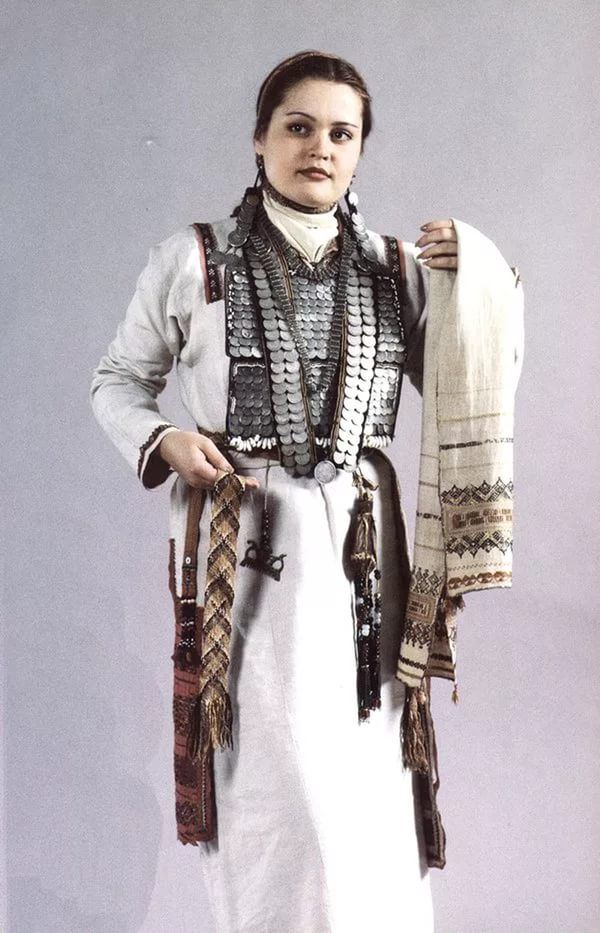
The Viryal traditions are closer to the Finno-Ugric ones, since they were in territorial contact with the mountain Mari. The embroidery patterns use geometric patterns and dark tones of green, blue and red. Viryal did not accept the motley crew and even physically punished the fashionistas. Tukhya viryal is richly embroidered, but there is much less silver on it than on its more southern neighbors. Surpan, compared to the previous ones, was small (only 1.2-1.5 m) and narrow. Its decoration was double-sided embroidery with a geometric pattern, beads and fringe. Masmak - in the form of a narrow strip of colored fabric embroidered with symbols of the creation of the world.


 3
3

